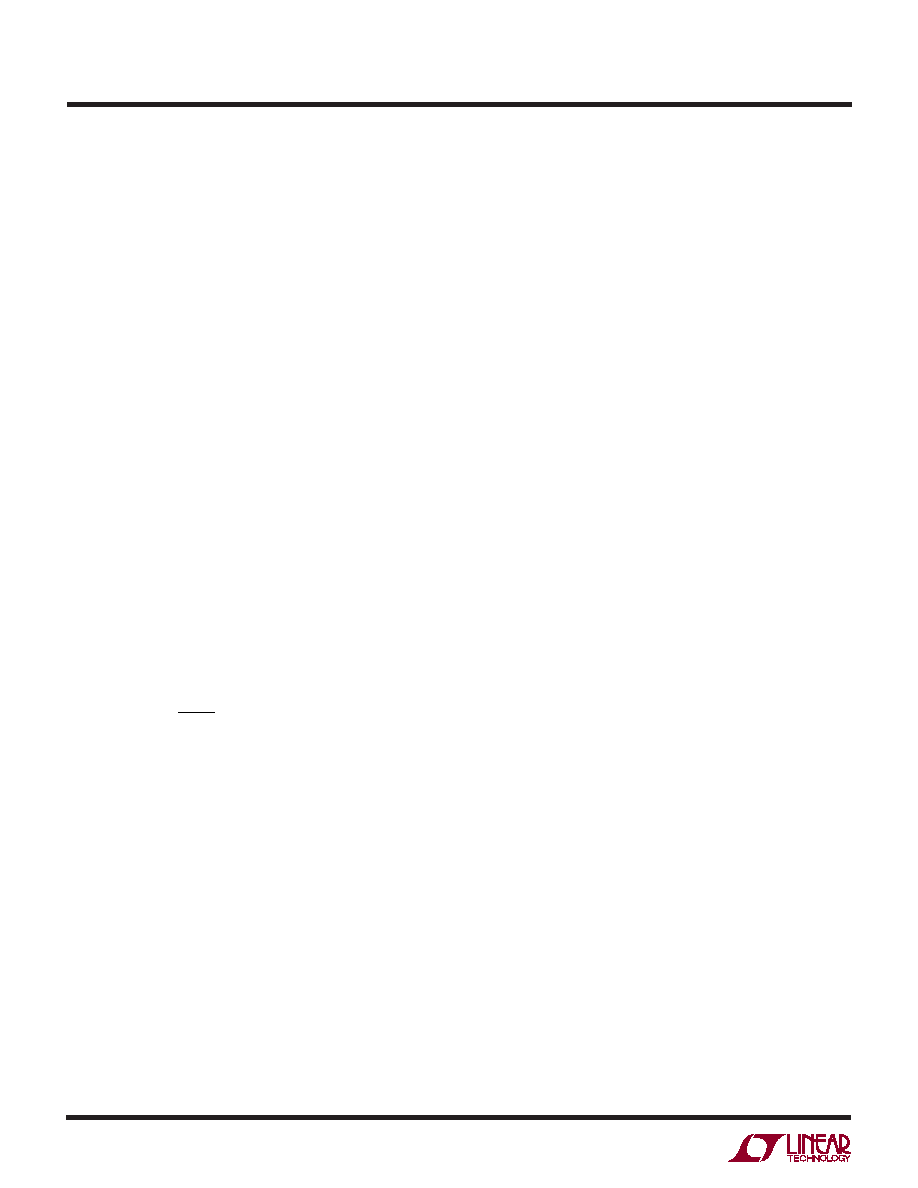- 您现在的位置:买卖IC网 > PDF目录44981 > LT1680ISW#TRPBF (LINEAR TECHNOLOGY CORP) SWITCHING CONTROLLER, 200 kHz SWITCHING FREQ-MAX, PDSO16 PDF资料下载
参数资料
| 型号: | LT1680ISW#TRPBF |
| 厂商: | LINEAR TECHNOLOGY CORP |
| 元件分类: | 稳压器 |
| 英文描述: | SWITCHING CONTROLLER, 200 kHz SWITCHING FREQ-MAX, PDSO16 |
| 封装: | 0.300 INCH, PLASTIC, SOP-16 |
| 文件页数: | 6/16页 |
| 文件大小: | 217K |
| 代理商: | LT1680ISW#TRPBF |

14
LT1680
output currents and diode current ratings must be ob-
served with caution. The peak diode current is:
ID(PEAK) = IAVG + I/2
and the average power dissipation (PD) in the diode is:
PD = (IOUT)(Vf)
where Vf is the forward voltage of the diode at peak
current. The output diode must also be rated for maximum
reverse voltages exceeding VOUT.
CIN and COUT Supply Decoupling Capacitor Selection
The large currents typical of LT1680 applications require
special consideration for the regulator input and output
supply decoupling capacitors.
Under normal steady state boost operation, output current
provided by the converter is a square wave of duty cycle VIN/
VOUT, the average value being equal to the required DC load
current (IOUT). The continuity of the load current is main-
tained by the output bypass capacitors. To prevent exces-
sive output voltage ripple and undue capacitor heating (and
associated catastrophic failure), low ESR output capacitors
sized for the maximum RMS current must be used. This
maximum capacitor RMS current follows the relation:
II
V
RMS
OUT
IN
≈
–
/
1
12
Capacitor ripple current ratings are often based on only 2000
hours (3 months) lifetime; it is advisable to derate either the
ESR or temperature rating of capacitors for increased MTBF.
The input bypass capacitors generally have less ripple
current than the output bypass capacitors as the input
current in a boost converter is continuous. Input bypass
capacitor selection can be made using ripple current
ratings. Peak-to-peak ripple current is equal to the induc-
tor ripple current (
IL).
Efficiency Considerations and Heat Dissipation
High output power applications create an inherent con-
cern regarding power dissipation in regulator compo-
nents. Although high efficiencies are achieved using the
LT1680, the power dissipated in the regulator climbs to
relatively high values when the load draws large amounts
of power. Even at 90% efficiency, a 500W application has
conversion loss of 55W.
I2R dissipation in the MOSFET switch, sense resistor and
inductor series resistance can generate substantial con-
version loss under high current conditions. Generally, the
dominant I2R loss is evidenced in the FET switch, which is
proportional to the steady-state duty cycle, or conduction
time of the switch. For example, in a 5V to 48V boost
converter, the duty cycle is:
DC = 1 – (VIN/VOUT)
DC = 1 – 5/48
≈ 90%
The FET switch conducts inductor current for almost 90%
of the cycle time, and thus may require increased consid-
eration for dissipating I2R power.
Gate Drive Buffer
The LT1680 is designed to drive relatively large capacitive
loads. However, in certain applications, efficiency im-
provements can be realized by adding an external buffer
stage to drive the gate of the FET switch. When the switch
gate loads the driver output such that rise/fall times
exceed 100ns, buffers can sometimes result in efficiency
gains. Buffers can also reduce effects of back injection into
the gate driver output due to coupling of switch node
transitions through the switch FET CMILLER.
Optimizing Transient Response–
Compensation Component Values
The dominant compensation point for an LT1680 con-
verter is the VC pin (Pin 5), or error amplifier output. This
pin connects to an external series RC network, RVC and
CVC. The infinite permutations of input/output filtering,
capacitor ESR, input voltage, load current, etc. make for an
empirical method of optimizing loop response for a spe-
cific set of conditions.
Loop response can be observed by injecting a step change
in load current. This can be achieved by using a switchable
load. With the load switching, the transient response of the
output voltage can be observed with an oscilloscope.
Iterating through RC combinations will yield optimized
response. Refer to Application Note 19 in the
1990 Linear
Applications Handbook, Volume 1 for more information.
APPLICATIO S I FOR ATIO
WU
UU
相关PDF资料 |
PDF描述 |
|---|---|
| LT1702-7FB1 | 1-OUTPUT 500 W AC-DC REG PWR SUPPLY MODULE |
| LT1740-7DF | 1-OUTPUT 550 W AC-DC REG PWR SUPPLY MODULE |
| LT1740-7 | 1-OUTPUT 550 W AC-DC REG PWR SUPPLY MODULE |
| LT1840-7DZF | 1-OUTPUT 450 W AC-DC REG PWR SUPPLY MODULE |
| LT1240-7DZF | 1-OUTPUT 400 W AC-DC REG PWR SUPPLY MODULE |
相关代理商/技术参数 |
参数描述 |
|---|---|
| LT1681 | 制造商:LINER 制造商全称:Linear Technology 功能描述:Dual Transistor Synchronous Forward Controller |
| LT1681ESW | 功能描述:IC SYNCHRONOUS FWRD CTRLR 20SOIC RoHS:否 类别:集成电路 (IC) >> PMIC - 电源控制器,监视器 系列:- 产品培训模块:Lead (SnPb) Finish for COTS Obsolescence Mitigation Program 标准包装:2,500 系列:- 应用:多相控制器 输入电压:- 电源电压:9 V ~ 14 V 电流 - 电源:- 工作温度:-40°C ~ 85°C 安装类型:表面贴装 封装/外壳:40-WFQFN 裸露焊盘 供应商设备封装:40-TQFN-EP(5x5) 包装:带卷 (TR) |
| LT1681ESW#PBF | 功能描述:IC SYNCHRONOUS FWRD CTRLR 20SOIC RoHS:是 类别:集成电路 (IC) >> PMIC - 电源控制器,监视器 系列:- 产品培训模块:Lead (SnPb) Finish for COTS Obsolescence Mitigation Program 标准包装:2,500 系列:- 应用:多相控制器 输入电压:- 电源电压:9 V ~ 14 V 电流 - 电源:- 工作温度:-40°C ~ 85°C 安装类型:表面贴装 封装/外壳:40-WFQFN 裸露焊盘 供应商设备封装:40-TQFN-EP(5x5) 包装:带卷 (TR) |
| LT1681ESW#TR | 功能描述:IC SYNCHRONOUS FWRD CTRLR 20SOIC RoHS:否 类别:集成电路 (IC) >> PMIC - 电源控制器,监视器 系列:- 产品培训模块:Lead (SnPb) Finish for COTS Obsolescence Mitigation Program 标准包装:2,500 系列:- 应用:多相控制器 输入电压:- 电源电压:9 V ~ 14 V 电流 - 电源:- 工作温度:-40°C ~ 85°C 安装类型:表面贴装 封装/外壳:40-WFQFN 裸露焊盘 供应商设备封装:40-TQFN-EP(5x5) 包装:带卷 (TR) |
| LT1681ESW#TRPBF | 功能描述:IC SYNCHRONOUS FWRD CTRLR 20SOIC RoHS:是 类别:集成电路 (IC) >> PMIC - 电源控制器,监视器 系列:- 产品培训模块:Lead (SnPb) Finish for COTS Obsolescence Mitigation Program 标准包装:2,500 系列:- 应用:多相控制器 输入电压:- 电源电压:9 V ~ 14 V 电流 - 电源:- 工作温度:-40°C ~ 85°C 安装类型:表面贴装 封装/外壳:40-WFQFN 裸露焊盘 供应商设备封装:40-TQFN-EP(5x5) 包装:带卷 (TR) |
发布紧急采购,3分钟左右您将得到回复。